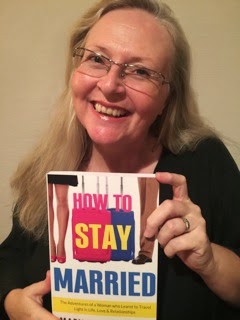This is a fascinating book, an at times alarmingly candid memoir of courtship and marriage in later life framed around a long and relationship-challenging holiday around the world. It begins with an open letter to all of those who have a desire to find a partner, and the author Mary-Lou Stephens wants you to know that once a man (or woman) is in the house, the really hard work is just beginning. “Relationships that last are not easy,” she counsels. “Getting to the place where you feel safe and happy is a journey.”
And How to Stay Married is an account of one such journey. Many of you will know Mary-Lou’s work from her previous memoir, a truly exceptional account of spiritual awakening called Sex, Drugs and Meditation. That is one of my very favourite books of recent years, and this follow up is a very satisfying work indeed for anyone who enjoys her confessional style and gentle, honest wisdom.
At the outset we are warned that this will be a book that pulls no punches in discussing the fallibility of human relationship, particularly when it is romantic and sexual in nature. Mary-Lou confesses to being a rule follower but secret resenter, and this passive-aggressive capacity (one at which Australians, myself included, excel) is turned on her hapless husband who bungles travel arrangements and is too confident in his own abilities. It begins the round of revealing stories that need to be read occasionally rough one’s fingers – is she really saying that about her husband? Has he read the book? It makes for a compelling and utterly absorbing read. (And, for the record, he has read the book, and gave the author complete carte blanche to say whatever she wanted to about their relationship).
 |
| Mary-Lou Stephens |
Mary-Lou pulls no punches in depicting the unusual suite of anxieties we bring to our romantic endeavours in the 21st Century. How to refer to one’s relationship, for example. He hated to be “the boyfriend’ and she hated the ambiguity of “my partner,” and so marriage became a way to resolve linguistic worries. And then there’s the question of desire, or at least its direction. On first meeting her future husband she had mistakenly assumed he was gay, and so almost missed the opportunity to connect with her life partner.
At one point in this book the author and her husband go to spend some time at the famous Findhorn spiritual community in Scotland. This place, famous for its nature spirits and giant cabbages, is brilliantly evoked by Stephens as she recounts the blandness of a communal setting, and the unexpected jealousies and annoyances that pop up just when she was hoping to be at her most spiritual. There’s a neurotic American woman flirting with her husband, for example, and neither of them can bear the bland vegetarian fare on offer.
 |
| Findhorn community, Scotland |
It is Mary-Lou Stephens’ eye for detail and her capacity to call out pretension that make her such a brilliant chronicler of modern living. And her-real-word dilemmas and contradictory calls remind us of ourselves as we read. Despite her general lack of enthusiasm, for example, about the realities of Findhorn, she finds herself fantasising about living there, and becoming a whole different kind of person. Anyone who has done a residential spiritual retreat will recognise these fantasies that spring forth in moments of enthusiasm, usually coupled with matching episodes of anger and contempt.
What makes How to Stay Married so special, and so very engaging, is its author’s ability to capture and really speak out loud the things that plague us about establishing a long-term partnership with another flawed human being. As more and more of us find ourselves single in our later years, we have to confront the awkwardness of learning to make new compromises long after we have settled into our own ways. Mary-Lou occasionally resents her husband’s wildly confident pronouncements on diverse subjects, for example. And occasionally she gets furious at his own spark of independence, along with his rather hopeless approach to personal finances. I defy anyone to read the book and not experience a twinge of recognition and guilt when she describes some unsatisfying example of her flawed but very real partnership.
Mary-Lou is good, too, at describing the simpler, almost primal comforts of being in the company of another person more or less constantly. Her new husband is physically unlike other men she has been with, and this new experience still occasionally surprises and delights her:
“I’m also thankful for being the wife of a big man. Big in stature, in girth and in spirit. I am safe in the company of strangers, in a rough working class pub, with this man beside me.”
Ultimately this exquisite book is a testament to the great folly of romantic engagement with another human being. Yes, such adventures are unequal, wildly frustrating and even, occasionally, soul-wounding. Our partner does become our mirror, in which we can begin to recognise those qualities, good and bad, that make us so unique. How to Stay Married is a book of great humanity, and it is unique in its willingness to speak the complete truth about the pressures of companionship. One to read for anyone who has ever been, or wanted to be, married.




Thank you Walter. Yes there were some parts of this book that I had to write through my fingers! A tricky thing to do. My wonderful writing group reassured me. They said that the things nobody wants to talk about are the things we need to be talking about. I think you might know the chapter it particular that I'm referring to. xx ML
ReplyDelete